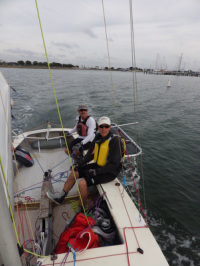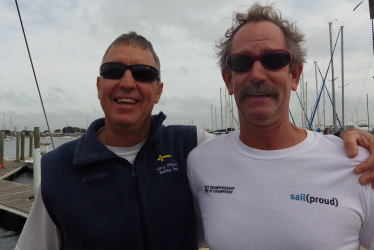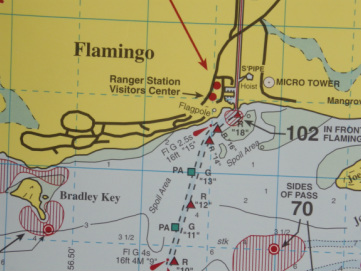 The Everglades Challenge sends a fleet of adventurous boating folks on a 300+ mile voyage from Tampa Bay to Key Largo in March. We've been hard at work on a highly modified Flying Scot we're calling Frankenscot that we hope to enter into the event.. A trip like this is not like gassing up the station wagon and hitting the highway. The course includes three check-in points along the way. Between here and there, we have open water and the Gulf of Mexico, various rivers and marked channels, mangrove islands, the Intracoastal Waterway. Plus, in this race, there are no rules against -- say -- cutting a corner and yanking the boat over shallow spots on foot, if need be.  Moresailesed and TwoBeers, December 2013. Moresailesed and TwoBeers, December 2013. Plotting a 300-mile course along the left side of Florida and through the 10,000 islands of the Everglades means making provisions for alternate routes, and alternate-to-the-alternate routes, and third-option-alternate routes. Is it better, one might consider, to stay inside the barrier islands or in the Gulf if the wind is piping up? It's not just the volume of breeze, but the direction, the likelihood of the wind backing or clocking (changing direction, in sailor-parlance), and of course the sea-state. Plus the tide, the waves, the time of day (it's good to avoid high-traffic Saturdays, for instance, along some of the stretches of water), etc. etc. etc. As with so many human endeavors, it's best to think about the options early: if it's dark and stormy and something (knock wood) goes bang, it's good to know already where to bolt to make repairs or take shelter. Far better to have already figured out that Tin Can channel is not recommended in certain wind conditions than to try to figure it out in the middle of the night. With the wind in the unfavored quarter. To that end, taking advantage of Moresailesed being in town, TwoBeers and Moresailesed got together recently to test the boat and to meet with Jarhead.
 The veteran of seven Challenges, first single-handed finisher in Class 4 in last year's EC (aboard a SeaPearl), and proud former Marine, Jarhead has been openhanded in sharing his wisdom. He may see us as young whippersnappers, but he's willing to tell us what he thinks about routes and alternate routes, especially for the toughest spots of the Everglades Challenge. With an amber FatTire close to hand, Jarhead walked an attentive group of sailors through his main navigation points. As he talked, the crowd built. Nothing speaks to sailors like experience, especially about something as tricky as nighttime, sleep-deprived navigation. My pages of notes include things like this: "Hug the shore to the lights on Chokoloskee Bay. Head for the lights, not the dark." And: "It's very tough to tack in the channel on an Easterly. Here's a thing to remember: if you are going to go aground, get stuck on the upwind side of the channel." And, yes, we resolved to squeeze in a few more reconnaissance trips to Florida Bay before that March 1st starting line.
6 Comments
Luke
1/1/2014 05:06:11 am
When Jarhead speaks, everone listens. The Frankenscot looks good! Don't worry about Florida Bay, it's easy...har,har,har.
Reply
Amy
1/1/2014 07:24:19 am
That's exactly how it was: Jarhead speaking, a rapt crowd listening.
Reply
greg
1/1/2014 05:34:41 am
Can't wait till the Moth Midwinters too cast my eye upon this nautical wonder. This sight shall cause many beers to be emptied. What an Adventure.
Reply
Amy
1/1/2014 07:25:40 am
Hey Greg,
Reply
Jay Lott
1/2/2014 03:41:38 am
This looks like a very cool project! I will watch with interest to see how the race goes. Having read all the blog posts on Frankenscot, I would guess a few weak points on the boat which you might want to reinforce (and probably you already thought of all of these) would be (a) the Flying Scot's gooseneck is pretty weak for the amount of pressure which can be put on it. An aftermarket reinforced gooseneck might be a good idea, (b) reinforce the gudgeons and use through-hull fasteners with some sort of plate on the inside; especially on an older boat, with enough torque on that rudder while screaming downwind, you could rip those gudgeons right out of the transom, (c) careful of putting too much pressure on the mast going upwind, by way of hiking leverage. I've seen Flying Scot masts break just above the sidestay attachment point, when too much weight on board plus too hard sail trim plus a big wave stopping you dead = snap, (d) I wonder whether a new mainsail with full battens and a lot of roach would be a cost effective way to add downwind speed. Or maybe not, as the mast isn't very tunable to depower a big main upwind.
Reply
Amy
1/2/2014 06:37:34 am
Thanks Jay for checking out the Frankie blogs -- the build has been pretty interesting so far.
Reply
Leave a Reply. |
About the Blog
A lot of ground gets covered on this blog -- from sailboat racing to book suggestions to plain old piffle. FollowTrying to keep track? Follow me on Facebook or Twitter or if you use an aggregator, click the RSS option below.
Old school? Sign up for the newsletter and I'll shoot you a short e-mail when there's something new.
Archives
June 2024
Categories
All
|

 RSS Feed
RSS Feed
